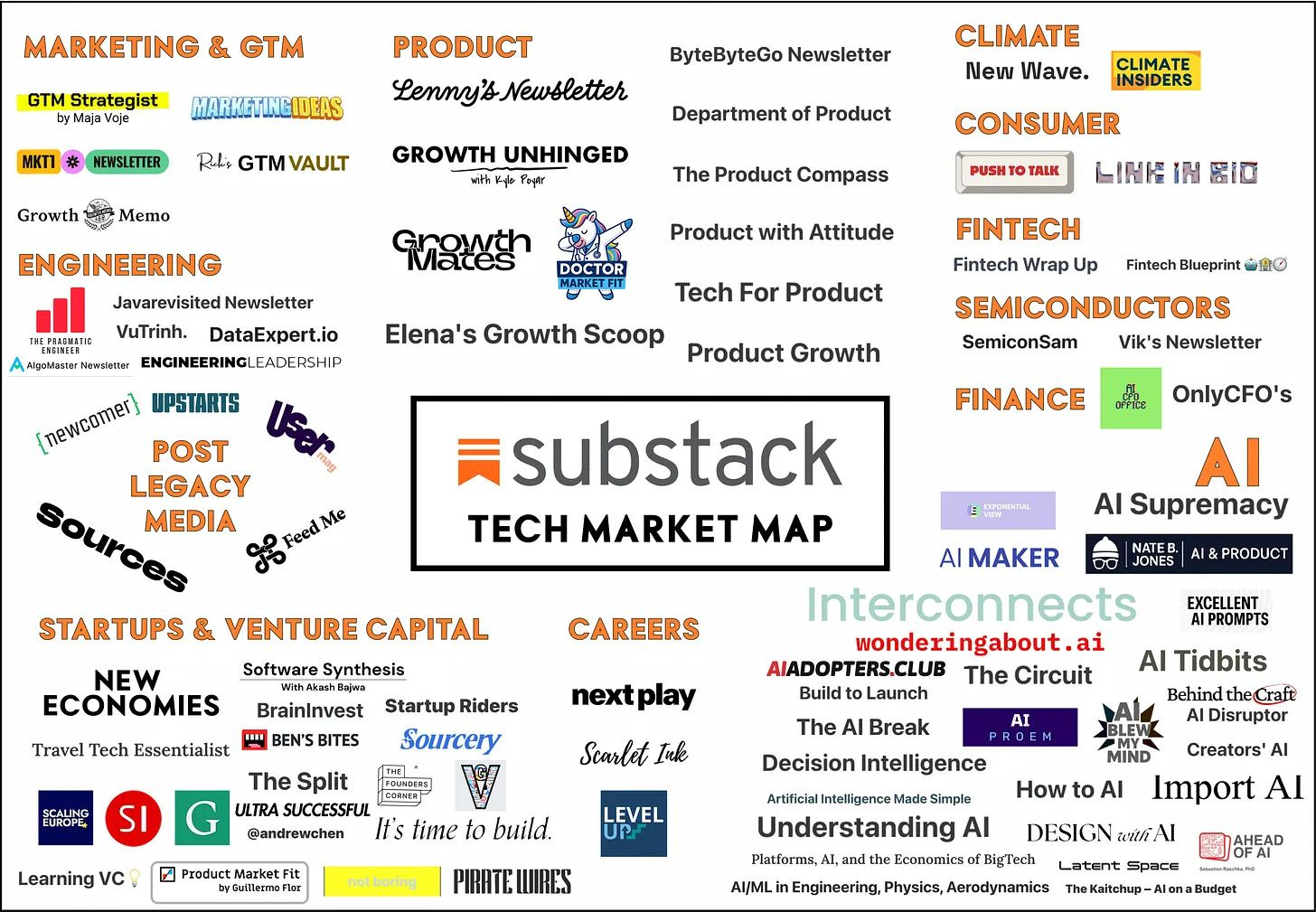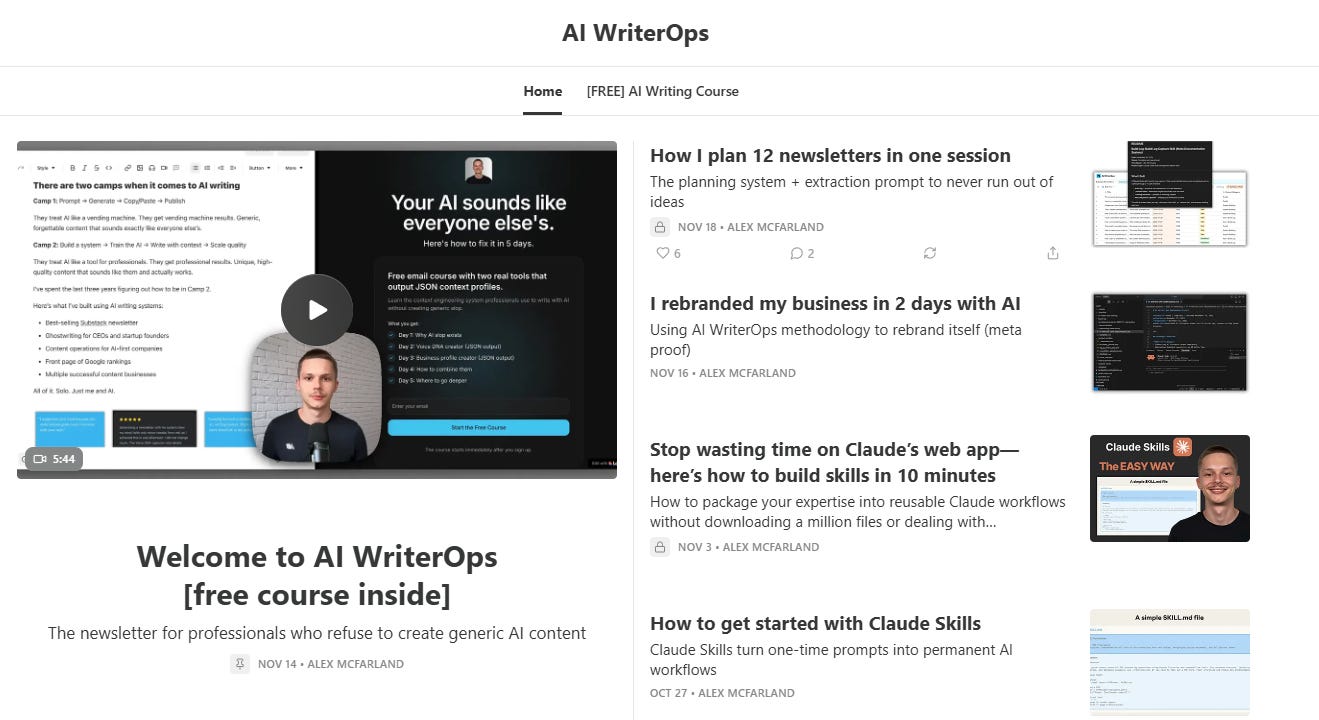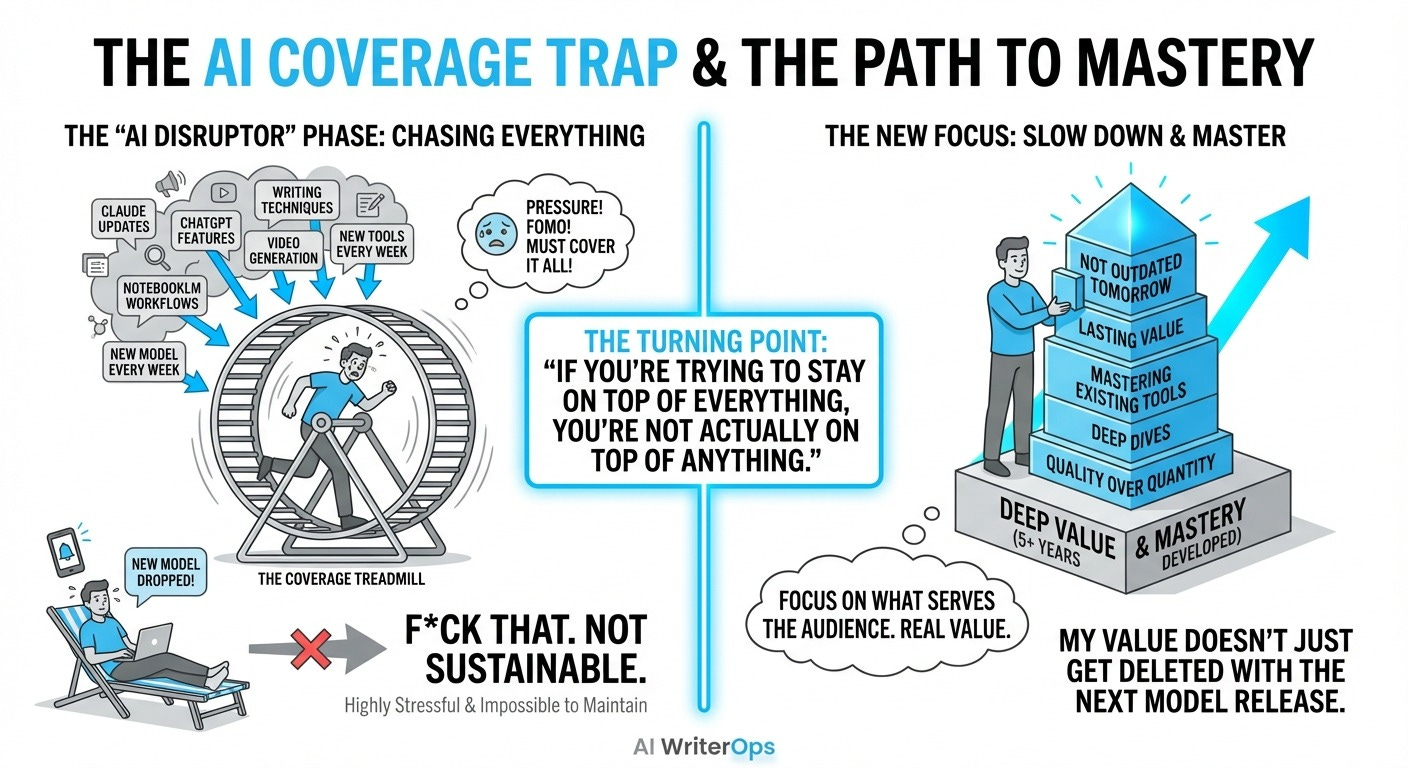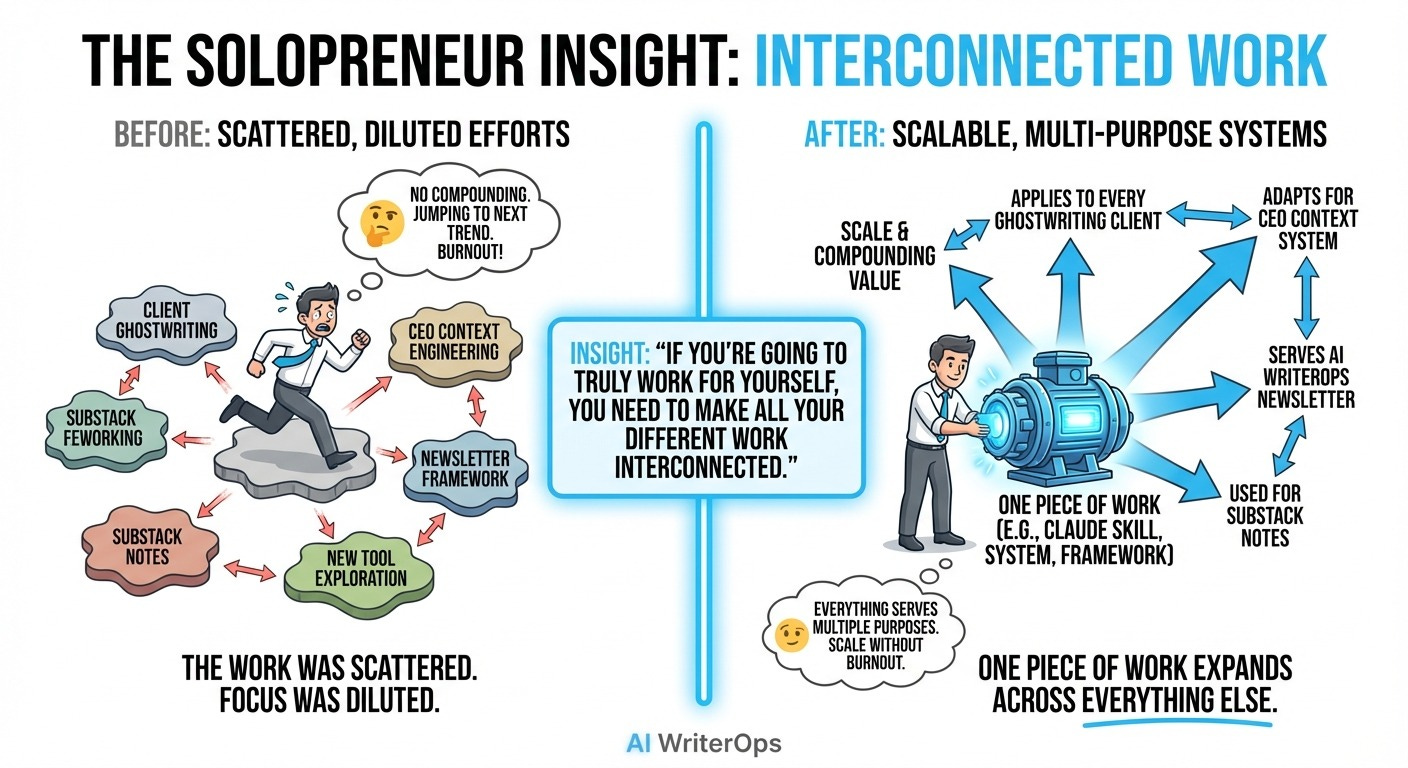Burnout, AI Slop, and Why I Nuked My Newsletter to Start Over
AI writing systems for Visionary founders, startups and leaders.
Good Morning,
I don’t often share a post on Saturday, but I wanted to offer a short biographical sketch of an AI creator. This is told as like a Business Insider-esque first-hand profile of an AI writer. But first a little bit of context.
AI Newsletters have Proliferated
When I started my flagship AI Newsletter, AI Supremacy, it was about 4 years ago and there were just three serious AI Newsletter on Substack. Most of those wrote some variety of weekly coverage and basic macro insights. Growth was slow, monetization was low, and I bootstrapped for literally years. Now things are a little different.
After ChatGPT came out, the AI Newsletters just kept multiplying, a new generation of AI Creators have risen up and in 2025 this has reached all-time new high levels. Today just weeks from 2026, there are literally thousands of AI Newsletters across Substack, beehiiv, Kit, LinkedIn and other platforms. I try my best to support and collaborate with these peers.
🎧 Listen to the first-hand account: (there’s an actual video by him further down).
made this incredible infographic below identifying and uplifting many of the new media voices in Substack’s ecosystem: (click on the image to read the report).
The Reality of being an AI Creator
But what happens to those creators as they take on multiple jobs, become consultants, take on freelance gigs, work with executives, take on ghost writer projects, build courses, use AI to become an entrepreneur and forge their own unique voice in the world? Does their quality of life get better?
What kind of burnout do they encounter? How do they learn to niche down?
has been one of my most viral and prolific AI guide writers as a guest contributor. He wrote one of the most popular NotebookLM guides of 2024.When I take on guest contributors to my publication, I’m also interested in their journey as professionals and as Creators. How does being augmented by AI also impact their trajectory and what kind of projects do they take on. How does their Newsletter focus and determination arrive at a more mature product? Where do they end up, and what do they end up building that counts? How does their mission align with their day to day? Where do they find their sweet-spot as entrepreneurs, builders and ultimate product-market fit? Independent writers aren’t that different from media founders.
The Relaunch - AI WriterOps is Born 🎓
Recently Alex re-launched his Newsletter to refocus on where he can make the biggest impact. AI Disruptor has been relaunched as AI WriterOps.
Relaunching your Newsletter in a more reader-centric niche can be useful to find the right balance. The value proposition has been clarified, the focus distilled, and the writer himself has evolved. All his insights have been bundled into an All-Access Yearly subscription.
This is that story.
AI WriterOps
Build AI writing operations that scale quality, not slop.
I asked Alex for his brutal and real take on this transition and repositioning in the now crowded AI Newsletter ecosystem. Alex’s videos, guides and practical advice on using AI in writing really stand out.
It’s not just about monetization - it’s about the learning. It’s about offering the most value to the world where your skills and interests also align.
How do you use AI in your writing, and how can it be tweaked? How can you build systems that help you use AI to scale, boost your productivity and improve your professional (and personal) life?
Unlocking an AI WriterOps Operating System
Mastering NotebookLM in 20 minutes
Welcome to AI WriterOps [free course inside]
How to get started with Claude Skills
I rebranded my business in 2 days with AI
Take the free writing course - start here.
Burnout, AI Slop, and Why I Nuked My Newsletter to Start Over
By
of AI Writer Ops Newsletter.This is told as the autobiographical account of the Creator Alex McFarland as an AI Creator, discussing burnout and his evolution - It’s been edited for length and clarity. Follow the guest contributor on his LinkedIn and follow his Notes.
Watch the Video - 7 minutes, 14 seconds - the story
Ed: Let us know if any part of this video spoke to you:
I killed my newsletter this month.
AI Disruptor. Many of you probably know me from it.
Not because it wasn’t working. It was growing fast. People were engaged. Revenue was coming in.
I killed it because I was burning out.
And I need to tell you why—because if you’re running an educational or content business in 2025, you’re about to make the same mistake I did.
The burnout wasn’t what you think
I run a lot.
I ghostwrite for startup CEOs and founders. I build their voice systems, their content operations, their entire writing infrastructure with AI. I run content operations for actual companies—marketing content, website copy, SEO strategies. I write daily news coverage for a top AI publication. I’m all over the front page of Google.
And then there’s my own stuff: Substack newsletter, video tutorials, live streams, a full training program.
All solo. Just me and the AI systems I’ve built.
The work itself? That’s not the burnout. I can handle the volume because I use AI to scale everything I do. The systems work.
The burnout came from something else entirely.
Instead of my Substack being a representation of everything I was learning doing that professional work, I was trying to do something completely different with the newsletter.
That just added to the pile of other stuff I had to do. That’s where the burnout came from. Not being able to connect all these things together.
AI Disruptor was the problem
My previous newsletter—the one many of you know me from—was called AI Disruptor.
The concept seemed smart. Cover everything happening in AI. I was qualified from years of working with it in the trenches.
Claude updates. ChatGPT features. NotebookLM workflows. Video generation. Writing techniques. New tools. All of it.
In the AI world, that’s simply not possible.
You know what it’s like right now. A new model drops every week. Features change daily. Tools launch constantly.
If you’re trying to stay on top of everything, you’re not actually on top of anything.
And working in AI? It’s stressful as hell. Nobody talks about this, but it’s highly stressful.
You feel this pressure to cover whatever new shiny thing just got released today.
I’d be at the beach, trying to enjoy my life, and I’d get a notification that a new Claude model just dropped. And I felt this necessity to go back to my computer right away and cover this before anybody else.
And I just said f*ck that. That’s not happening anymore.
There are very few people who can do that well. And if you’re doing that, you better be able to give people quality stuff and dive deep.
I knew that was not for me anymore. That’s not what serves my audience. That’s not what anybody needs.
We need to actually slow down and master what we have instead of trying to cover the surface level of every new thing that comes out.
My value doesn’t lie in covering the next new model that’s going to be outdated tomorrow.
My value lies in stuff I’ve developed over the past 5+ years. Stuff that doesn’t just get deleted with the next model release.
What I actually learned doing this work
All my “outside of Substack” work—the ghostwriting, the content operations, the company systems I build—that’s where my real expertise lives. That’s where I’ve spent years figuring out how to use AI without creating garbage.
When you ghostwrite for a CEO, you can’t pump out generic content. Their voice, their experience, their unique perspective, has to come through, or you’ve failed. When you run content operations for an actual company, surface-level doesn’t cut it. You need systems that scale quality, not volume.
I’ve spent years building AI writing systems that work. Systems that capture voice. Systems that maintain consistency across dozens of pieces of content. Systems that let one person do the work of an entire content team without sacrificing quality.
That’s the unique thing I bring to the table. Not surface-level coverage of every AI tool. Deep expertise in building AI writing operations that don’t suck.
Here’s the lesson: If you’re going to teach someone how to be successful at something, you better have real work outside your teaching to back it up. Too many people are teaching how to teach, or how to grow, or teaching generic advice that applies to nothing specific. Don’t be that person. The best way to grow is to niche down and have something valuable to share.
The solopreneur insight that changed everything
There’s something else I figured out: If you’re going to truly work for yourself, you need to make all your different work interconnected.
Here’s what I mean.
When I build a Claude skill for writing Substack notes for myself, that same skill helps every client I ghostwrite for. When I develop a newsletter framework for AI WriterOps, I can apply that methodology across all my ghostwriting clients. When I create a context engineering system for one CEO, I can adapt it for the next three.
One piece of work expands across everything else.
That’s when you can actually scale as a solopreneur without burning out. Not by working harder. By making everything you build serve multiple purposes.
But I couldn’t do that while trying to cover the entire AI world. The work was scattered. The focus was diluted. Nothing compounded because I was constantly jumping to the next tool, the next update, the next trend.
So I burned it all down
I launched AI WriterOps with one clear focus: Teaching people how to build AI writing operations that produce professional results, not AI slop.
Context engineering. Voice DNA systems. Claude skills. Agentic workflows. Reusable frameworks.
I niched down to exactly where I have unique, real expertise. The stuff I’ve spent years doing in private, for clients, for companies, for myself.
This goes beyond AI. It’s a lesson about focus.
When you try to be everything to everyone, you end up being nothing to anyone. When you niche down to where you have genuine expertise that nobody else can replicate—that’s when you become indispensable.
And here’s what happened.
Everything got easier. A huge weight lifted from my shoulders. I could think way more clearly.
Creating content got easier because I’m teaching what I actually do every day. My client work got better because I’m constantly refining the exact systems I teach. My newsletter serves my training program, which serves my client work, which serves my newsletter. Everything compounds.
The burnout didn’t come from doing too much work. It came from doing unfocused work.
What AI WriterOps actually is
If you’re doing any form of professional writing—marketing, ghostwriting, content operations, technical writing, social media—AI is the most powerful tool you have to scale your voice.
Especially if you’re a solopreneur. Especially if you’re ghostwriting. Especially if you’re running content operations.
AI is the greatest thing that ever happened to your career.
And you don’t have to be technical for this. Everything I teach is something you can learn. This is not highly technical stuff.
But what we’re all going to need IMO is an AI that actually understands our voice, our business, our context. Every single one of us and our clients.
That’s what AI WriterOps is about.
Building effective writing operations instead of just talking to ChatGPT through random prompts. We need to build Claude skills. We need to write system prompts with context. We need to create context profiles for our AIs.
Not surface-level tips. Not random prompts. Complete AI writing operations that make AI an extension of you—your voice, your expertise, your unique perspective.
Whether you’re running your own Substack, ghostwriting for clients, building your personal brand, or scaling content operations for a company, this is the path that actually works.
Three things you should take away (so you don’t have to go through what I did)
1. You can’t cover everything—and you shouldn’t try.
The winners aren’t the ones who know a little about everything (with some exceptions). They’re the ones who go deep. If you’re feeling scattered, overwhelmed, on a content treadmill going nowhere—niche down. Stop trying to be everything to everyone. Focus on where you have real, unique expertise that nobody else can replicate.
2. Make your work interconnected if you want to scale solo.
Build things once that serve multiple purposes. A skill you create for yourself should help your clients. A framework you develop for one project should adapt to the next three. That’s how you scale as a solopreneur without burning out. Not by working harder, but by making everything compound.
3. Stop treating AI like a vending machine.
Build systems. Engineer context. Capture voice. The difference between AI slop and professional AI writing is whether you’re prompting or building actual operations. If you’re using AI to write anything, you have a responsibility to do it right.
Because there’s way too much garbage out there already.
I just relaunched AI WriterOps with this new focus, and honestly, I’m more excited about this than anything I’ve built before.
If you use AI to create content—for yourself, your clients, your brand, your company—I’d love to have you in our community.
Let’s build something that doesn’t suck.
—Alex
PS: When you subscribe to AI WriterOps, you get a free 5-day AI writing course. Join over 9,000 builders.
Thanks for reading! Let us know if this touched on anything you find yourself working on as well? How do you deal with burnout and niching down in the AI Newsletter economy if you are a writer, creator or freelancers as well or in your job in general? AI isn’t just changing the internet, it’s changing how content operators live and work. It’s impacting the journey of Creators themselves.
We’d love to hear your story around writing and AI too. Especially as it regards burnout, refining your purpose, finding new meaning and maybe even niching down too. It’s almost 2026, there are a lot of good Newsletters about writing with AI out there.











So now we know the traps. Thanks for this !!